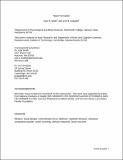Habit formation
Author(s)
Smith, Kyle S.; Graybiel, Ann M
DownloadGraybiel_Habit formation.pdf (306.8Kb)
OPEN_ACCESS_POLICY
Open Access Policy
Creative Commons Attribution-Noncommercial-Share Alike
Terms of use
Metadata
Show full item recordAbstract
Habits, both good ones and bad ones, are pervasive in animal behavior. Important frameworks have been developed to understand habits through psychological and neurobiological studies. This work has given us a rich understanding of brain networks that promote habits, and has also helped us to understand what constitutes a habitual behavior as opposed to a behavior that is more flexible and prospective. Mounting evidence from studies using neural recording methods suggests that habit formation is not a simple process. We review this evidence and take the position that habits could be sculpted from multiple dissociable changes in neural activity. These changes occur across multiple brain regions and even within single brain regions. This strategy of classifying components of a habit based on different brain signals provides a potentially useful new way to conceive of disorders that involve overly fixed behaviors as arising from different potential dysfunctions within the brain's habit network.
Date issued
2016-03Department
Massachusetts Institute of Technology. Department of Brain and Cognitive Sciences; McGovern Institute for Brain Research at MITJournal
Dialogues in Clinical Neuroscience
Publisher
AICH - Servier Research Group
Citation
Smith, Kyle S., and Ann M. Graybiel. "Habit formation." Dialogues in Clinical Neuroscience 2016; 18 (1): 33-43.
Version: Author's final manuscript
ISSN
1958-5969